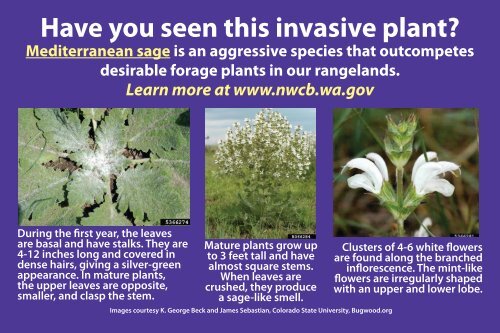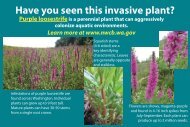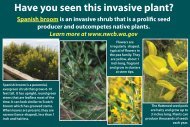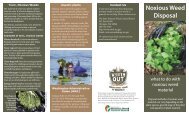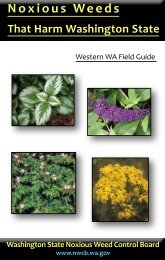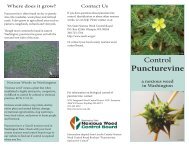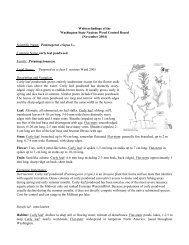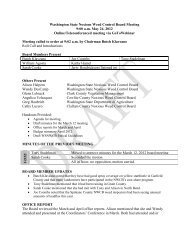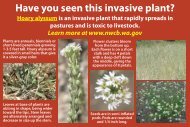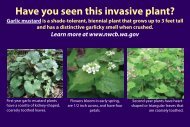Have you seen this invasive plant? - Washington State Noxious ...
Have you seen this invasive plant? - Washington State Noxious ...
Have you seen this invasive plant? - Washington State Noxious ...
- No tags were found...
You also want an ePaper? Increase the reach of your titles
YUMPU automatically turns print PDFs into web optimized ePapers that Google loves.
<strong>Have</strong> <strong>you</strong> <strong>seen</strong> <strong>this</strong> <strong>invasive</strong> <strong>plant</strong>?Mediterranean sage is an aggressive species that outcompetesdesirable forage <strong>plant</strong>s in our rangelands.Learn more at www.nwcb.wa.govDuring the first year, the leavesare basal and have stalks. They are4-12 inches long and covered indense hairs, giving a silver-greenappearance. In mature <strong>plant</strong>s,the upper leaves are opposite,smaller, and clasp the stem.Mature <strong>plant</strong>s grow upto 3 feet tall and havealmost square stems.When leaves arecrushed, they producea sage-like smell.Images courtesy K. George Beck and James Sebastian, Colorado <strong>State</strong> University, Bugwood.orgClusters of 4-6 white flowersare found along the branchedinflorescence. The mint-likeflowers are irregularly shapedwith an upper and lower lobe.
Why is Mediterranean sage (Salvia aethiopis) a noxious weed?• Mediterranean sage outcompetes beneficial forage<strong>plant</strong>s and is unpalatable to livestock and wildlife.• This biennial or short-lived perennial invades bothdisturbed and undisturbed habitats.Where do <strong>you</strong> find Mediterranean sage?• Well-drained riparian areas, pastures, and rangelandsare the most common habitats to find <strong>this</strong> <strong>plant</strong>.• Mediterranean sage is very limited in distribution andis found primarily in southwestern <strong>Washington</strong>.• Common mullein grows in similar habitats and can beconfused with Mediterranean sage; however, mulleinflowers are yellow, and leaves are not toothed and donot smell like sage.What can <strong>you</strong> do?• Learn to correctly identify <strong>this</strong> Class A noxious weed.• Please note that eradication is required in <strong>Washington</strong>to prevent it from gaining a foothold.• Report any sightings to <strong>you</strong>r county noxious weedcontrol board or to noxiousweeds@agr.wa.gov.Printed 6/2010


